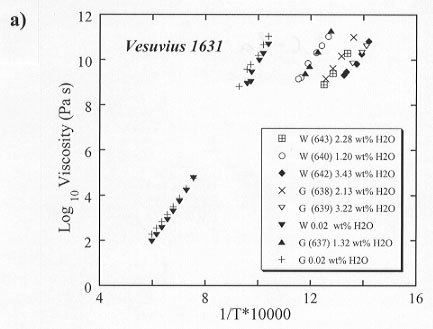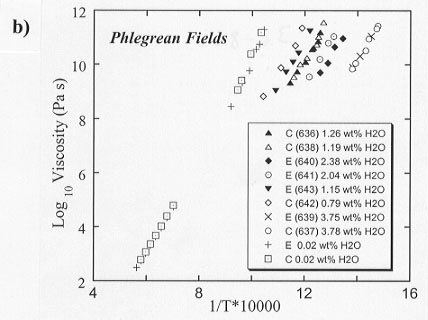

The Phlegrean Fields caldera and the Vesuvius volcano, located west of Naples in Southern Italy have produced highly destructive eruptions several times in their history, and they would present a significant danger if they were to be reactivated. Understanding how the magma evolves with time so as to predict future eruptive scenarios for these two volcanic systems is critical for hazard assessment and planning in and around the Naples area.
The viscous response of magma to applied stresses in the magma body and in the conduit controls the fluid dynamics of magma ascent. Adequate numerical simulation of such scenarios requires detailed knowledge of the viscosity of the magma. Viscosity is a sensitive function of melt composition, especially silica content, alkalinity, and volatile content as well as crystal and bubble content. Current models for the calculation of viscosity are not applicable to alkaline magmas because the only model that accounts for the non-Arrhenian variation of viscosity with temperature is limited to calcalkaline magma compositions. In this study, we have performed an extensive experimental analysis of the viscosities of selected lavas from the Phlegrean Fields system and the Vesuvius volcano in order to quantitatively define the volcanic scenarios of these two systems. Reference volcanic eruptions have been selected from the past history of the two volcanoes, and are represented by Agnano Monte Spina (4400 BC) and the 1631 AD eruption of Vesuvius.
The glass samples were hydrated via piston cylinder synthesis at P=1 GPa and T=1600° C. The water contents of the run products (ranging from 0.79 to 3.78 wt%) were determined by IR spectroscopy. The low-temperature anhydrous and hydrous viscosities were measured using a modified micropenetration method for viscosities between 108.45 to 1011.35 Pa s, at 1 atm pressure and in the temperature ranges of 404-686° C and 684-814° C for the dry and wet melts, respectively. The high-temperature viscosity data for the anydrous samples were obtained by concentric-cylinder viscometry in a temperature range 1050 to 1500° C. The viscosities of the dry and hydrous melts are presented as a function of reciprocal temperature in Figures 3.6-8a and 3.6-8b, respectively. Addition of water to the melts results in a large shift of the viscosity-temperature relationship to lower temperatures, in good agreement with the trend observed for a wide range of natural as well as synthetic melts. The viscosity drops dramatically between 0 and 1 wt% H2O and levels off at higher water content.
Low- and high-temperature data have all been fitted using a VFT-type equation, which has been modified to introduce a composition dependence of water for each VFT parameter. The general form of the equation used is:
 |
(1) |
where a1, a2, b1, b2, c1 and c2 are the fit parameters,  is the viscosity in Pascal seconds, W is the concentration of water in weight percent, and T is the temperature in Kelvin. Four different equations have been generated to account for the slight but perceptible difference in chemical composition among the different sets of samples.
is the viscosity in Pascal seconds, W is the concentration of water in weight percent, and T is the temperature in Kelvin. Four different equations have been generated to account for the slight but perceptible difference in chemical composition among the different sets of samples.
These equations have then been used to parameterise the viscosities to be used as input into models of magma response in various eruption scenarios.
 |
 |
Fig. 3.6-8a, b: Viscosity-temperature relationships for trachytic melts with variable water content from (a) Vesuvius volcano and (b) Phlegrean Fields volcanic system. The variation of viscosity with water content at constant temperature is strongly nonlinear similar to that observed for phonolitic and calcalkaline rhyolitic melts. |

Tel: +49-(0) 921 55 3700 / 3766, Fax: +49-(0) 921 55 3769, E-mail: bayerisches.geoinstitut(at)uni-bayreuth.de
 Previous page
Previous page